Ear-Shy Horses

How to Correct a Dangerous Behavior
Ear-shy horses make haltering and bridling nearly impossible and downright dangerous with their head tossing, pulling away and even rearing up or striking out. Horses become ear shy for a number of reasons. Some cases are caused by physical problems such as ear infections, mites and warts to name just a few. If you suspect your horse’s fear of having his ears touched is because of a physical problem, the first step is to consult with your veterinarian. After identifying and treating the problem and the physical symptoms are gone, the ear shyness often disappears as well. But, physical problems are not the usual culprits of an ear shy horse. Instead, most ear-shy problems rest in the horse being afraid of his ears being handled because the horse has never been introduced to the concept, he’s had prior rough treatment or he’s just disrespectful. If your horse cops an attitude when you reach for his ears, here’s your step-by-step guide to taking away his fear.
Build His Confidence with Approach and Retreat
You’ll get your horse over his fear by desensitizing him to your hands touching his ears using the Approach and Retreat Method. You’ll start by rubbing your horse’s body in an area he’s comfortable with and then gradually working your way to his ears. By approaching him and then retreating when he stands still and shows a sign of relaxing, you’ll build his confidence. When a horse relaxes, he’ll do one of five things: he’ll lick his lips, lower his head, blink his eyes, cock a hind leg or take a big breath. When he stands still and shows one of these signs of relaxing, you’ll retreat and go back to rubbing him in a spot he’s comfortable with, such as his neck or withers. Sometimes a horse won’t show you any of these signs, but as long as he stands still for 15 seconds, you can take away the pressure. If a horse stands still for 15 seconds, he’s telling you that he’s not interested in running. He may still be a little frightened, but he’s starting to use the thinking side of his brain and has chosen to stand still.
The number-one rule to remember when using Approach and Retreat is not to retreat until the horse stands still and shows a sign of relaxing. If you retreat while he’s moving and using the reactive side of his brain, you’ll teach him the opposite of what you want. Instead of him standing still and relaxing, he’ll think the answer to getting you to stop touching his ears is to run from you. Remember, as prey animals, horses have an ingrained flight or fight response. You have to constantly reinforce to them that the answer is not to run from a perceived danger, but to stand still and relax. Approach and Retreat will build the horse’s confidence and trust so that you can eventually rub and touch all over his ears.
Since you won’t be trying to stop the horse from moving his feet, the best place to practice desensitizing him is in an open area like an arena or 50-foot roundpen. That way, if he does get nervous and tries to move away from you, he can move his feet while you follow him and continue to rub him until he stands still and relaxes. The worst place to practice the Approach and Retreat Method is in a closed, confined area like a stall, grooming bay or while the horse is tied up because he’ll feel like he’s trapped and can’t move his feet. When a prey animal feels trapped and his ability to take flight is taken away from him, he’ll become defensive and fight. So set your horse up for success by practicing the steps outlined below in an open area where he won’t feel trapped and claustrophobic.
Teaching Stage
1) Stand to the side of the horse and hold onto the cheekpiece of the halter with the hand closest to his nose so you can keep his head straight.
You’re not trying to hold the horse’s head down with the halter, but it’s best to hold onto the halter so that if he does get defensive and tries to throw his head up in the air to get away from your hand, he doesn’t smack you in the face. Or, some horses will try to evade your touch by stretching their head and neck away from you. As long as you keep a hand on the halter, you’ll be able to safely desensitize the horse.
2) Using Approach and Retreat, vigorously rub the crest of the horse’s neck with your free hand, working your way up toward his ears.
Be sure to rub the palm of your hand in a firm, circular motion with a lot of feel. Be sure that you’re rubbing the horse with the palm of your hand and not patting him. Rubbing feels good to the horse and will relax him, while patting feels uncomfortable. When you rub the horse, use a firm touch with a lot of feel. You don’t want to be rough with the horse, but you don’t want to be so gentle that you tickle him either. Be very obvious in your actions – rubbing him and then retreating when he stands still and relaxes. You want this to be a pleasant experience that he looks forward to. Remember, the more you sneak around a horse, the more he thinks there’s a reason to be scared and worried. Just act casual as if the horse doesn’t have a problem in the world.
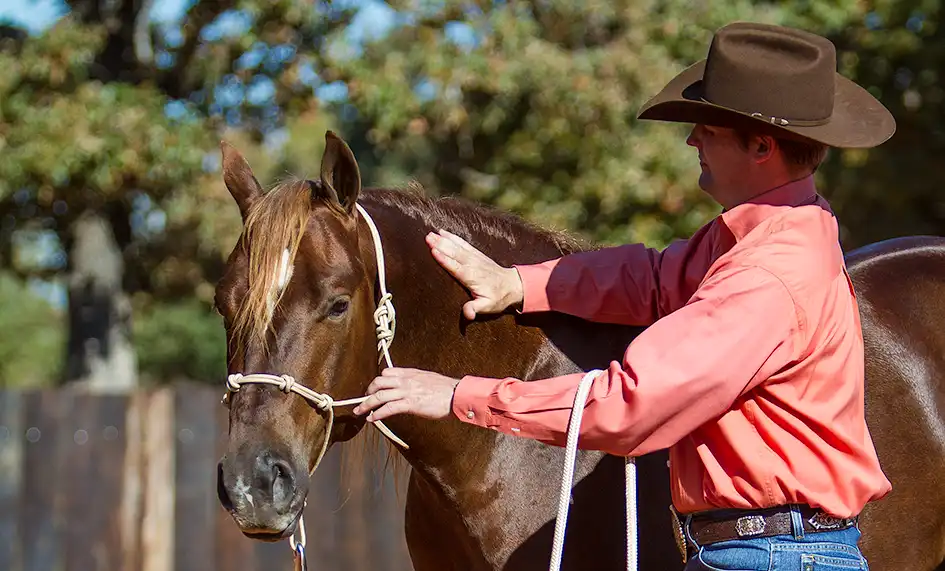
Start by rubbing the crest of the horse’s neck with your hand in a firm, circular motion.
3) Continue to rub the horse until he stands still and shows a sign of relaxing.
As soon as he does, retreat and rub his topline in a place he’s comfortable. The secret is to stop approaching the horse’s ear before he thinks you’re going to try and touch it. So if you get within 6 inches of touching the horse’s ear and he starts to act nervous, don’t move on from that spot until he stands still and relaxes, and then retreat. Retreating is the complete opposite of walking up to the horse and grabbing a hold of his ear. Prove to him that you’re not even interested in touching his ear. You’re just rubbing his neck. The more often you retreat, the more confident the horse will become. When the horse does stand still and relax, retreat by rubbing his topline in a place he’s comfortable, whether that’s the crest of his neck or back by his withers.
4) Then approach the horse again.
Each time you rub his neck, try to move farther away from the starting point. Once you’ve established a starting point (a place the horse is comfortable with you touching) then you can gradually build on it. Each time you approach, you should be getting a little closer to his ears.
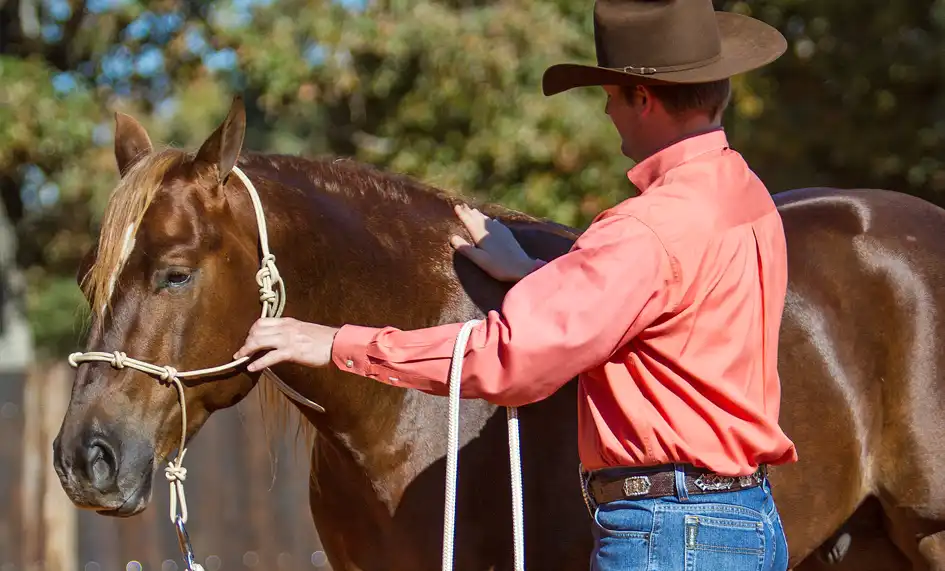
When the horse stands still and shows a sign of relaxing, retreat and rub his topline in a place he’s comfortable with you touching him.
5) As you rub the horse, be on the lookout for “Oh no, don’t touch me there!” spots.
If you find an “Oh no, don’t touch me there!” spot, continue to rub that exact spot until the horse stands still and relaxes. As soon as he relaxes, retreat by rubbing in an area he’s comfortable with. Then come back to the “Oh no!” spot again and rub him. Repeat that process, approaching and retreating, until the horse no longer cares if you rub the “Oh no!” spot. If you find an “Oh no, don’t touch me there!” spot, it’s important that you keep rubbing the horse in that exact spot until he stands still and relaxes. If you stop rubbing when he’s tense and moving his feet, you’ll teach him that when you touch him in that spot, it’s OK for him to resist you. For example, if the horse is uncomfortable with you rubbing near his poll and you stop touching him there as soon as he moves his feet or throws his head up, you’ll teach him that he doesn’t have to tolerate you touching him there. You want the horse to realize that the only way he can escape your touch is by standing still and relaxing.
6) Continue rubbing, using the Approach and Retreat Method, until you can rub in between the horse’s ears.
It may take you five or six repetitions of Approach and Retreat to get your hand in between the horse’s ears. It doesn’t matter how long it takes, just do what you have to do to get the job done. If your horse is really ear shy, you may have to work on just rubbing his neck and getting close to his ears for an entire day. Once you get to the point of rubbing your hand between his ears, don’t even try to touch his ears. Just continue to rub your hand on his poll until he’s really comfortable with it.
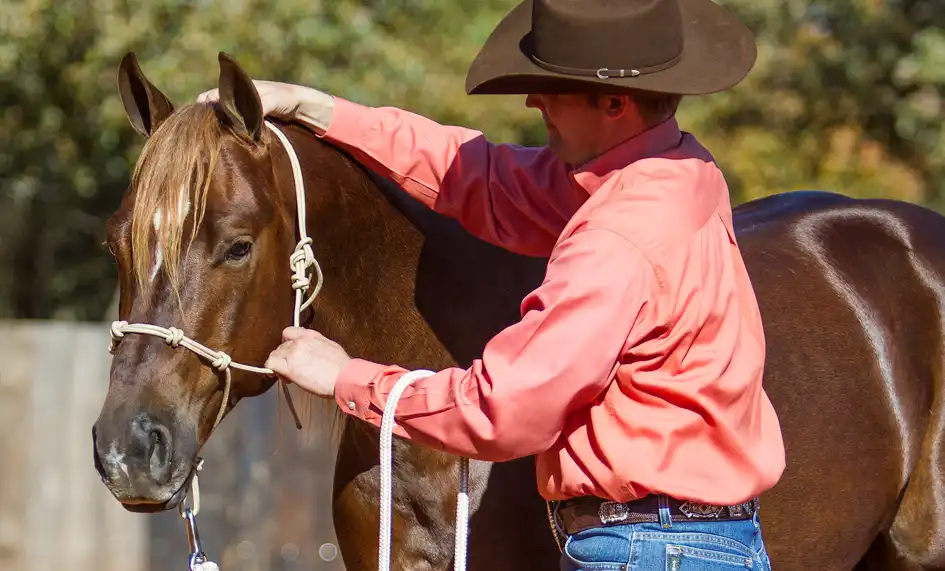
As you’re rubbing the horse, keep your hand constantly moving – do not try to rub or hold his ears at this point.
7) Work your hand farther down the horse’s head by rubbing his forehead.
Then retreat and rub your hand on his poll and down his neck. Do not try to rub or hold his ear – only rub the space between his ears or the area right below his ear.
8) When the horse is comfortable with you rubbing your hand down his forehead, you can brush your hand over his ear.
Start by rubbing the crest of his neck, and in one smooth motion, rub your hand over one ear and onto his forehead. Do not attempt to grab his ear – just brush your hand against it. When you start to desensitize the horse’s ears, don’t grab onto the ears. Snatching the ears and holding onto them is very similar to what a predator would do. Instead, you want to pretend like the ears aren’t even there. You’re just rubbing the horse’s forehead and brushing over his ears. See how floppy you can make the horse’s ears. The floppier they are, the more relaxed he is.
9) Rub up the crest of his neck and then rub your hand around the base of his ear for a second before retreating back to his neck.
Continue using Approach and Retreat until the horse accepts having the base of his ear rubbed.
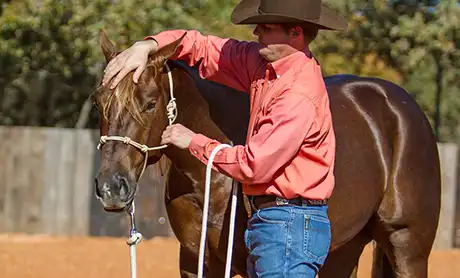
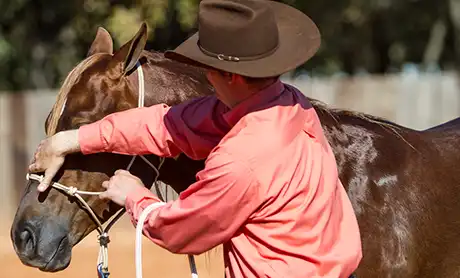
Using Approach and Retreat, work your way up to being able to rub in between the horse’s ears and down the length of his face.
10) Rub your hand up and down the outside of his ear.
If he tries to pull his head away from you, stay with him and keep your hand on his ear until he relaxes. Remember, don’t retreat until the horse is standing still and showing a sign of relaxing. If you take your hand away when he’s moving his feet and trying to get away from you, you’ll teach him that if he wants to escape your touch, all he has to do is run away from you. Prove to him that the quickest way to get rid of your hand is to stand still and relax.
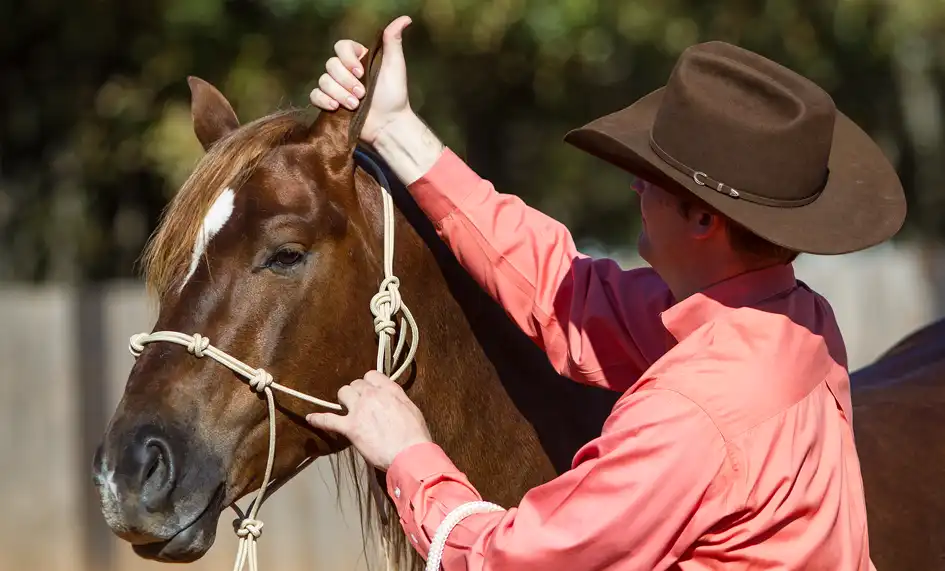
When the horse is comfortable with you rubbing around the base of his ear, rub your hand up and down the outside of his ear.
11) When the horse accepts you touching the outside of his ear, rub your thumb inside his ear.
Start by just rubbing the inside tip of his ear and use Approach and Retreat to gradually work your way down to the inside base of his ear. Establish a starting point and then build on it. Don’t go from touching the outside of the horse’s ear to trying to rub your thumb inside the entire length of his ear. Start with just the tip and then work your way up to being able to touch the inside of his entire ear.
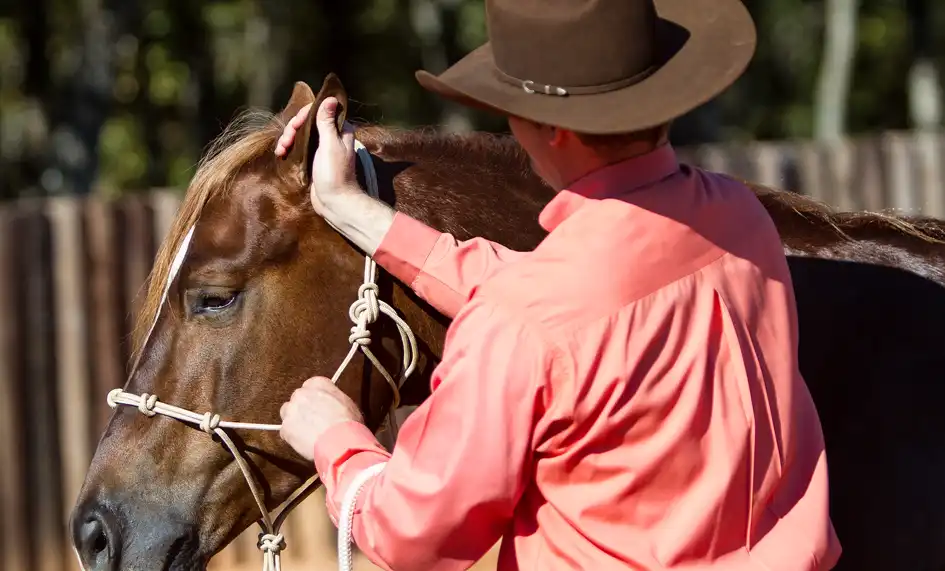
Then rub your thumb inside of his ear. Start by just rubbing the tip of his ear.
Mistakes to Avoid
Patting the horse rather than rubbing him.
Always rub the horse with a lot of feel to your hand. Rubbing is a soothing sensation that will relax and comfort him. Patting doesn’t feel comfortable to the horse and will make him want to get away from you.
Retreating from an “Oh no!” spot before the horse stands still and relaxes.
If you find an “Oh no, don’t touch me there!” spot when you’re rubbing the horse, do not leave that area until he stands still and relaxes. If you stop rubbing that area before he stands still and relaxes, you’ll teach him that to make your hand go away, all he has to do is resist you. As soon as he relaxes, retreat by rubbing in a different area. Then repeat the process again, approaching and then retreating when he stands still and relaxes.
Not establishing a starting point.
When you first start desensitizing the horse’s ears to your touch, remember to establish a starting point. A starting point is a place the horse is comfortable with you touching. Depending on how defensive the horse is around his ears, your starting point might be the crest of his neck or even back on his withers. Once you have a starting point established, then you can build on it.
Trying to stop the horse from moving.
If the horse gets frightened or defensive toward you touching an area of his body, don’t try to stop him from moving. Instead, continue holding the cheekpiece of the halter to keep his head tipped toward you and follow him wherever he goes, continuing to rub whatever area you were touching that made him react. The only way you’ll stop rubbing him is when he stands still and shows a sign of relaxing. If you try to force the horse to stop by jerking down on the lead rope, you’ll make him feel trapped and he’ll become even more reactive. It’ll take patience, but it’s important that the horse realizes that if he wants you to stop touching him, he needs to keep his feet still and relax.
Horse Problems
Horse throws his head up in the air.
If the horse throws his head up in the air when you touch him, just follow him and continue to rub him in that exact spot. Your hand goes wherever his head goes. When he throws his head up, he’s just telling you that he’s not comfortable with you touching him in that spot, and he’s trying to get you to stop touching him there by throwing his head up. You’re going to teach him that the only way you’ll stop rubbing his ear is if he stands still and relaxes. If you stop rubbing when the horse throws his head up, you’ll teach him just the opposite, which is if he doesn’t want you to touch him, all he has to do is throw his head up in the air. If the horse throws his head up so high that you can’t reach his ear, just keep your hand as close to his ear as you can. If the horse is reacting badly, he’s telling you that you’re progressing too quickly. You have to go back and get the previous steps more solid.
Horse backs up.
If the horse tries to back up, just follow him backwards while continuing to rub him until he stands still AND shows a sign of relaxing. Keep his nose tipped slightly toward you with the hand that’s holding the cheekpiece of the halter. If the horse has a big problem with his ears being touched, incorporate it into your daily groundwork. Practice desensitizing his ears in between each sensitizing exercise until he thinks that having his ears rubbed is the best part of the day because he gets to stand still and rest. Don’t try to desensitize his ears if he’s fresh and full of energy; do it after some groundwork when he’s tired and looking for a place to rest.
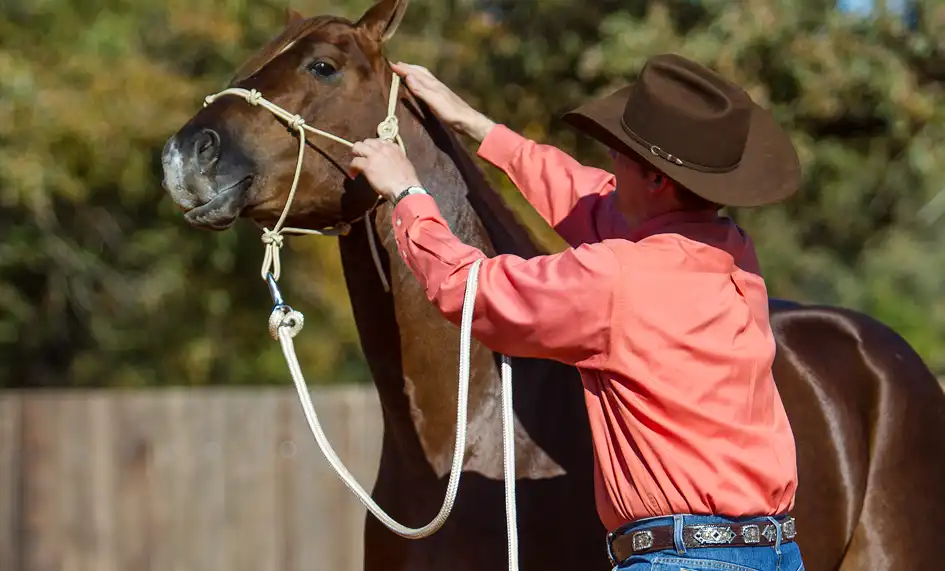
If the horse raises his head in an attempt to escape your touch, just keep his head tipped toward you, follow him and continue to try to touch him until he stands still and shows a sign of relaxing.
Horse backs up.
If the horse tries to back up, just follow him backwards while continuing to rub him until he stands still AND shows a sign of relaxing. Keep his nose tipped slightly toward you with the hand that’s holding the cheekpiece of the halter. If the horse has a big problem with his ears being touched, incorporate it into your daily groundwork. Practice desensitizing his ears in between each sensitizing exercise until he thinks that having his ears rubbed is the best part of the day because he gets to stand still and rest. Don’t try to desensitize his ears if he’s fresh and full of energy; do it after some groundwork when he’s tired and looking for a place to rest.

Drop the Excuses
How to deal with a horse that doesn’t like his ears touched or is head shy in some form is one of the most common questions I’m asked. Here’s how the conversation usually starts: “Clinton, I have this horse that was severely abused. Because his previous owner used to hit him, he’s scared of anything coming near his head. What do I do?” Or, “Clinton, my horse is blind in one eye and gets really scared when I raise my hand next to his blind side. I don’t want to scare him more, but what do I do?”
The answer is always the same – forget the horse’s past and fix the problem. Making excuses and special allowances for an abused horse’s bad behavior will only limit him, while treating him the same as any other horse will actually accelerate his progress. All horses are looking for a leader that will keep them safe, but while horses are natural followers, they only want to follow a leader they respect and trust. Every day your horse will test you to see if you deserve to lead him, which means that you have to be worthy of your leadership role. You have to prove to him that you can move his feet forwards, backwards, left and right and are always willing to reward the slightest try. All of the exercises in the Method are geared toward developing a relationship, building trust and earning the respect of a horse. For that reason, it’s the perfect remedy for horses that have been abused and neglected by humans. Although abuse is a terrible thing, once a horse is brought back to health, treating him just the same as you would treat any other horse breaks the cycle of abused-related behavior and sets you on the track to enjoying a great partnership. It’s absolutely amazing to see how quickly the horse will start to trust and respect you if you treat him like any other horse.
Success Tips
Don’t Sneak Around.
The biggest mistake people make with horses that are head shy is trying to protect them by sneaking around. I have a saying when I’m working around horses, “Heart attacks are free.” In other words, don’t tip-toe around your horse and be afraid to scare him. In reality, trying to protect your horse from objects he’s scared of only makes the situation worse. As a trainer, your goal is to desensitize your horse to as many objects that move and make a noise as you can. You can’t get that done if you’re afraid to scare him. When I’m desensitizing a horse, if he wants to get scared, that’s fine by me. Heart attacks are free. As long as I’m in a safe position, I don’t care if he has a heart attack.
Don’t Act Like a Predator.
While I don’t want you to sneak around your horse, I also don’t want you to act like a predator and walk straight up to him and grab his ear. That’ll only frighten him and turn the situation into a fight. Whenever you’re working your horse through a situation he’s scared of or introducing him to a new object, always use the Approach and Retreat Method.
“The more often you retreat, the more confident the horse will become”
What Won’t Work
- Yelling at the horse
- Losing your temper or becoming frustrated
- Being in a hurry
- Tying the horse to a post to practice desensitizing him
- Working with the horse in a closed, confined area where he can’t move his feet
- Jerking on the lead rope to try to stop the horse from moving

